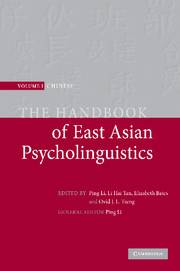Book contents
- Frontmatter
- Contents
- List of figures
- Notes on contributors
- Preface
- Introduction: new frontiers in Chinese psycholinguistics
- Part I Language acquisition
- Part II Language processing
- 14 Word-form encoding in Chinese speech production
- 15 Effects of semantic radical consistency and combinability on Chinese character processing
- 16 Eye movement in Chinese reading: basic processes and crosslinguistic differences
- 17 The Chinese character in psycholinguistic research: form, structure, and the reader
- 18 Perception and production of Mandarin Chinese tones
- 19 Phonological mediation in visual word recognition in English and Chinese
- 20 Reading Chinese characters: orthography, phonology, meaning, and the Lexical Constituency Model
- 21 Processing of characters by native Chinese readers
- 22 L2 acquisition and processing of Mandarin tones
- 23 The comprehension of coreference in Chinese discourse
- 24 Lexical ambiguity resolution in Chinese sentence processing
- Part III Language and the brain
- Epilogue: a tribute to Elizabeth Bates
- References
- Name index
- Subject index
15 - Effects of semantic radical consistency and combinability on Chinese character processing
Published online by Cambridge University Press: 05 June 2012
- Frontmatter
- Contents
- List of figures
- Notes on contributors
- Preface
- Introduction: new frontiers in Chinese psycholinguistics
- Part I Language acquisition
- Part II Language processing
- 14 Word-form encoding in Chinese speech production
- 15 Effects of semantic radical consistency and combinability on Chinese character processing
- 16 Eye movement in Chinese reading: basic processes and crosslinguistic differences
- 17 The Chinese character in psycholinguistic research: form, structure, and the reader
- 18 Perception and production of Mandarin Chinese tones
- 19 Phonological mediation in visual word recognition in English and Chinese
- 20 Reading Chinese characters: orthography, phonology, meaning, and the Lexical Constituency Model
- 21 Processing of characters by native Chinese readers
- 22 L2 acquisition and processing of Mandarin tones
- 23 The comprehension of coreference in Chinese discourse
- 24 Lexical ambiguity resolution in Chinese sentence processing
- Part III Language and the brain
- Epilogue: a tribute to Elizabeth Bates
- References
- Name index
- Subject index
Summary
A sentence in Chinese consists of Chinese characters strung together with equal spacing between individual characters. Usually two or more characters constitute a Chinese word, though a Chinese character can be a word in its own right. There are no particular markers to differentiate between Chinese words and characters in a sentence. For these reasons, it can be stated that, fundamentally, Chinese characters are the building blocks of Chinese reading. It is therefore important to understand how single characters are processed and organized in the mental lexicon. Here we are concerned with semantic processing in single Chinese character identification and categorization.
Approximately 80 percent of Chinese characters are phonetic compounds which are composed of a semantic radical and a phonetic (Zhou, 1978). In principle, the phonetic is a clue to the pronunciation of the whole character whereas the semantic radical is a clue to its meaning. This is a unique feature of Chinese phonetic compounds because clues for the meaning and the pronunciation of a character are separate and localized in two different parts of the character. This feature enables researchers to investigate the effects of semantic information and phonological information separately from orthographic information in character identification. This is much more difficult to do in alphabetic scripts.
There has been much research into the involvement of phonology in Chinese character identification (e.g. Fang, Horng & Tzeng, 1986; Hue, 1992).
- Type
- Chapter
- Information
- The Handbook of East Asian Psycholinguistics , pp. 175 - 186Publisher: Cambridge University PressPrint publication year: 2006
- 3
- Cited by



